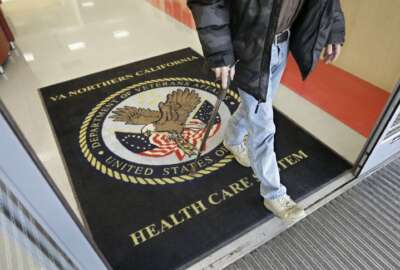
How VA is beginning the 10-year push to adopt a new electronic health record
The Veterans Affairs Department is upgrading its infrastructure and beginning data migration to prepare for its upcoming implementation of a new electronic health...
Subscribe to Federal Drive’s daily audio interviews on iTunes or PodcastOne.
The Veterans Affairs Department has a new motto in 2018.
Health care and IT professionals in the department are looking at their “18 for ’18” — 18 collaborative projects and priorities that both the Veterans Health Administration and VA Office of Information and Technology (VAOT) are looking toward for this year.
Telehealth, veterans homelessness and suicide prevention are among the 18. But the new electronic health record has a prominent spot on the list, and it’s perhaps the biggest priority that will consume practically every facet of the department — that will extend well beyond 2018.
“[We want to] get very crystal clear on what we’re going to deliver, particularly in a world in which we don’t have infinite resources,” Scott Blackburn, executive in charge for VA’s Office of Information and Technology, said Tuesday during AFCEA Bethesda’s Health IT Day. “Typically at the VA, we get distracted by shiny objects, so if things come up, we can talk about what the trade-offs are that we’re going to make so that we can deliver on what we say we’re going to deliver.”
VA Secretary David Shulkin in June announced his plans to adopt MHS Genesis, the same EHR system the Defense Department is already deploying. The Pentagon is implementing the health record to sites in the Pacific Northwest, and VA said it intends to follow DoD’s same deployment path.
VA hasn’t yet announced a final contract with Cerner Corporation, the same vendor behind DoD’s electronic health record. The whole project is expected to take 10 years.
In the meantime, VA is upgrading its infrastructure now, so each site is physically prepared to use the new Cerner system when it’s eventually deployed.
“We can’t take the brand new engine and stick it on the Model T and expect it to do something different than the Model T did,” said John Short, executive director for information technology systems migration at VA’s Office of Information and Technology (VA OI&T).
VA OI&T is installing new fiber, ports, switches, computers and monitors, along with other equipment that users will need, at each EHR site about six months before Cerner installation, Short said.
“One of our plans is to make sure that that before a new EHR gets deployed to a new site, that we’ve already deployed the infrastructure upgrades there,” he said. “We don’t want the cabling, the fiber and the switches to be occurring while a user is trying to learn a new system.”
The department is also creating data migration and workflow plans for the new EHR. The goal, Short said, is to be better prepared to pare down about 130 different versions of VA’s homegrown Veterans Information Systems and Technology Architecture (VistA).
“We are migrating 30 plus years of data to the Cerner data center,” Short said. “We’ve already created the data migration plan. We’ve already done little piece tests of the data migration plan as part of the contract negotiations, so that Cerner Corporation knows how to come back and propose to us how they will do that.”
Creating a better online experience for veterans is another key priority driving VA’s new IT modernization roadmap.
To improve the online experience for veterans, VA is taking lessons from top-performing customer service organizations like USAA.
The department has several dozen different customer-facing websites and applications, from My HealtheVet and Benefits.gov to Vets.gov. Veterans find it difficult to navigate them all and remember what applications offer a specific service.
“We’ve probably created a little bit more of a fragmented experience than what we wanted to, but we’re going to fix that,” Blackburn said. “The way I’m envisioning the future is if people want to go to My HealtheVet or Vets.gov, it’s going to end up going back to the same place. They still go to the URL that they’re familiar with, and whether they’re going to be on a Cerner system or some kind of VistA based system for their experience, they still click. All of that happens behind the scenes.”
Specifically, the department is looking to application programming interfaces (APIs), and they’re getting ready to make some of them public.
VA plans to set up a sandbox environment where outside vendors can develop and test new APIs, and the department is asking the public for suggestions of new applications that may benefit veteran users.
Bill James, deputy assistant secretary for VA’s Enterprise Program Management Office, said he sees the potential for an application that can verify a veteran’s status as an example where industry could contribute and collaborate.
“We want veterans to have that very same choice about the experience that they have with VA products, services [and] IT applications,” James said. “[We’re] flipping that whole relationship around so veterans are empowered and that we service their needs, as opposed to us dictating a digital relationship.”
What about VistA?
The department will support each instance of VistA until it implements the new Cerner system at each corresponding DoD and VA site. The departments have planned a deployment schedule that begins at sites in the Pacific Northwest and moves east.
“We can’t starve VistA for the next decade,” Blackburn said. “That’s not fair to people in Miami and eastern seaboard that are going to be using that. We have to make some very strategic, targeted investments to maintain the state-of-the-art nature of VistA, things like scheduling systems, whatever that might be to keep that going. Maintaining two large systems for 10 years is going to be a challenge.”
The department recently finished mapping and reviewing all VistA modules, and it plans to stop adding new capabilities to VistA modules that the department will eventually retire.
“Freeze doesn’t mean ‘laissez-faire,'” James said. “Freeze means [we will] stop adding new stuff. Freeze means what you have running. It still has to run every single day. We still have mission on the current modules. We’ll stop adding new stuff as we get to the point where we know how it’ll be replaced.”
Copyright © 2025 Federal News Network. All rights reserved. This website is not intended for users located within the European Economic Area.
Nicole Ogrysko is a reporter for Federal News Network focusing on the federal workforce and federal pay and benefits.
Follow @nogryskoWFED
Related Stories





